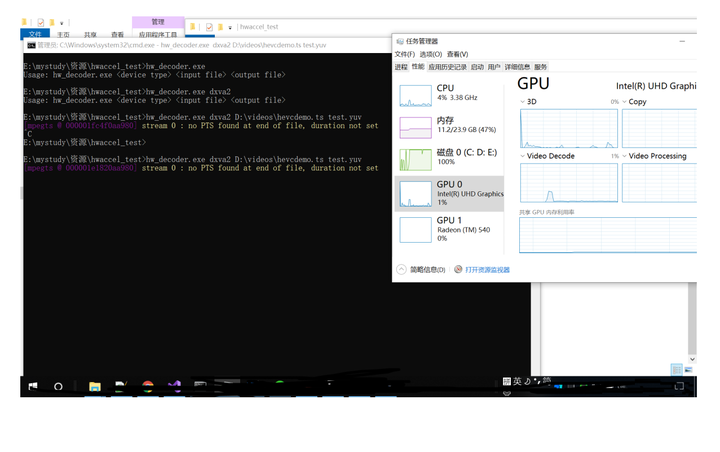【FFmpeg实战】FFMPEG硬件编解码 |
您所在的位置:网站首页 › flash硬件加速在哪里 › 【FFmpeg实战】FFMPEG硬件编解码 |
【FFmpeg实战】FFMPEG硬件编解码
|
转载自 原文地址:https://cloud.tencent.com/developer/article/2021911 一、基本概况ffmpeg对显卡厂家SDK进行封装和集成,实现部分的硬件编解码 NVIDIAAMDINTEL编码器xxx_nvencxxx_amfxxxx_qsv解码器xxx_ cuvid暂未实现xxxx_qsvffmpeg硬解编解码应用 其中xxx标识编码类型,如h264,h265,mpeg2,vp8,vp9等。其次在ffmpeg中软件编解码器可以实现相关硬解加速。如在h264解码器中可以使用cuda 加速,qsv加速,dxva2 加速,d3d11va加速,opencl加速等。 cudaqsvdxva2/d3d11vaopencl应用场景适应NVIDIA显卡平台,但跨OS适应Intel显卡平台,但跨OS适用Windows OS,但跨硬件平台仅仅支持opencl的硬件平台 二、命令行的使用在ffmpeg中,如果使用-vcodec xxx 指定硬件编解码器,否则使用软件编解码。 如: ffplay -x 800 -y 600 -vcodec h264_qsv h264.mp4 ffplay -x 800 -y 600 -vcodec hevc_qsv 4k_hevc.mp4 ffmpeg.exe -i test.ts -vcodec hevc_amf -s 1280x720 output.ts 三、代码中使用1)使用特定的编解码器 任何一个编解码器包都是由AVCodec来描述的。其中ID代表一类编码器或解码。如: AV_CODEC_ID_H264;代表是h264编解码器。而name代表某一个编码器或解码器。通常我们使用avcodec_find_decoder(ID)和avcodec_find_encoder(ID)来解码器和编码器。默认采用的软件编解码。如果我们需要使用硬件编解码,采用avcodec_find_encoder_by_name(name)和avcodec_find_decoder_by_name(name)来指定编码器。其他代码流程与软件编解码一致。 如: //codec = avcodec_find_decoder(AV_CODEC_ID_H264); codec = avcodec_find_decoder_by_name("h264_cuvid"); if (!codec) { fprintf(stderr, "Codec not found\n"); exit(1); }2)使用硬件加速 使用特定的编解码器好处就是跨操作系统,不论是Windows还是Linux都是一套代码,但缺点就是不跨硬件,不同显卡厂家采用不同编解码器。而基于软件编码器的硬件加速是跨硬件显卡的,如Windows d3d11va硬件加速,无论底层是AMD显卡还是Intel显卡还是nvidia显卡都适用,相当于windows 系统屏蔽了硬件细节,我们只需要调用windows的API实现即可。下面一个基于硬件加速的demo static AVBufferRef* hw_device_ctx = NULL; static enum AVPixelFormat hw_pix_fmt; static FILE* output_file = NULL; //硬件加速初始化 static int hw_decoder_init(AVCodecContext* ctx, const enum AVHWDeviceType type) { int err = 0; //创建一个硬件设备上下文 if ((err = av_hwdevice_ctx_create(&hw_device_ctx, type, NULL, NULL, 0)) < 0) { fprintf(stderr, "Failed to create specified HW device.\n"); return err; } ctx->hw_device_ctx = av_buffer_ref(hw_device_ctx); return err; } //获取GPU硬件解码帧的格式 static enum AVPixelFormat get_hw_format(AVCodecContext* ctx, const enum AVPixelFormat* pix_fmts) { const enum AVPixelFormat* p; for (p = pix_fmts; *p != -1; p++) { if (*p == hw_pix_fmt) return *p; } fprintf(stderr, "Failed to get HW surface format.\n"); return AV_PIX_FMT_NONE; } //解码后数据格式转换,GPU到CPU拷贝,YUV数据dump到文件 static int decode_write(AVCodecContext* avctx, AVPacket* packet) { AVFrame* frame = NULL, * sw_frame = NULL; AVFrame* tmp_frame = NULL; uint8_t* buffer = NULL; int size; int ret = 0; ret = avcodec_send_packet(avctx, packet); if (ret < 0) { fprintf(stderr, "Error during decoding\n"); return ret; } while (1) { if (!(frame = av_frame_alloc()) || !(sw_frame = av_frame_alloc())) { fprintf(stderr, "Can not alloc frame\n"); ret = AVERROR(ENOMEM); goto fail; } ret = avcodec_receive_frame(avctx, frame); if (ret == AVERROR(EAGAIN) || ret == AVERROR_EOF) { av_frame_free(&frame); av_frame_free(&sw_frame); return 0; } else if (ret < 0) { fprintf(stderr, "Error while decoding\n"); goto fail; } if (frame->format == hw_pix_fmt) { /* 将解码后的数据从GPU内存存格式转为CPU内存格式,并完成GPU到CPU内存的拷贝*/ if ((ret = av_hwframe_transfer_data(sw_frame, frame, 0)) < 0) { fprintf(stderr, "Error transferring the data to system memory\n"); goto fail; } tmp_frame = sw_frame; } else tmp_frame = frame; //计算一张YUV图需要的内存 大小 size = av_image_get_buffer_size((AVPixelFormat)tmp_frame->format, tmp_frame->width, tmp_frame->height, 1); //分配内存 buffer = (uint8_t *)av_malloc(size); if (!buffer) { fprintf(stderr, "Can not alloc buffer\n"); ret = AVERROR(ENOMEM); goto fail; } //将图片数据拷贝的buffer中(按行拷贝) ret = av_image_copy_to_buffer(buffer, size, (const uint8_t* const*)tmp_frame->data, (const int*)tmp_frame->linesize, (AVPixelFormat)tmp_frame->format, tmp_frame->width, tmp_frame->height, 1); if (ret < 0) { fprintf(stderr, "Can not copy image to buffer\n"); goto fail; } //buffer数据dump到文件 if ((ret = fwrite(buffer, 1, size, output_file)) < 0) { fprintf(stderr, "Failed to dump raw data.\n"); goto fail; } fail: av_frame_free(&frame); av_frame_free(&sw_frame); av_freep(&buffer); if (ret < 0) return ret; } } int main(int argc,char * argv[]) { AVFormatContext* input_ctx = NULL; int video_stream, ret; AVStream* video = NULL; AVCodecContext* decoder_ctx = NULL; AVCodec* decoder = NULL; AVPacket packet; enum AVHWDeviceType type; int i; if (argc < 4) { fprintf(stderr, "Usage: %s \n", argv[0]); return -1; } // 设备类型为:cuda dxva2 qsv d3d11va opencl,通常在windows使用d3d11va或者dxva2 type = av_hwdevice_find_type_by_name(argv[1]); //根据设备名找到设备类型 if (type == AV_HWDEVICE_TYPE_NONE) { fprintf(stderr, "Device type %s is not supported.\n", argv[1]); fprintf(stderr, "Available device types:"); while ((type = av_hwdevice_iterate_types(type)) != AV_HWDEVICE_TYPE_NONE) fprintf(stderr, " %s", av_hwdevice_get_type_name(type)); fprintf(stderr, "\n"); return -1; } /* open the input file */ if (avformat_open_input(&input_ctx, argv[2], NULL, NULL) != 0) { fprintf(stderr, "Cannot open input file '%s'\n", argv[2]); return -1; } if (avformat_find_stream_info(input_ctx, NULL) < 0) { fprintf(stderr, "Cannot find input stream information.\n"); return -1; } /* find the video stream information */ ret = av_find_best_stream(input_ctx, AVMEDIA_TYPE_VIDEO, -1, -1, &decoder, 0); if (ret < 0) { fprintf(stderr, "Cannot find a video stream in the input file\n"); return -1; } video_stream = ret; //查找到对应硬件类型解码后的数据格式 for (i = 0;; i++) { const AVCodecHWConfig* config = avcodec_get_hw_config(decoder, i); if (!config) { fprintf(stderr, "Decoder %s does not support device type %s.\n", decoder->name, av_hwdevice_get_type_name(type)); return -1; } if (config->methods & AV_CODEC_HW_CONFIG_METHOD_HW_DEVICE_CTX && config->device_type == type) { hw_pix_fmt = config->pix_fmt; break; } } if (!(decoder_ctx = avcodec_alloc_context3(decoder))) return AVERROR(ENOMEM); video = input_ctx->streams[video_stream]; if (avcodec_parameters_to_context(decoder_ctx, video->codecpar) < 0) return -1; decoder_ctx->get_format = get_hw_format; //硬件加速初始化 if (hw_decoder_init(decoder_ctx, type) < 0) return -1; if ((ret = avcodec_open2(decoder_ctx, decoder, NULL)) < 0) { fprintf(stderr, "Failed to open codec for stream #%u\n", video_stream); return -1; } /* open the file to dump raw data */ output_file = fopen(argv[3], "w+b"); /* actual decoding and dump the raw data */ while (ret >= 0) { if ((ret = av_read_frame(input_ctx, &packet)) < 0) break; if (video_stream == packet.stream_index) ret = decode_write(decoder_ctx, &packet); //解码并dump文件 av_packet_unref(&packet); } /* flush the decoder */ packet.data = NULL; packet.size = 0; ret = decode_write(decoder_ctx, &packet); av_packet_unref(&packet); if (output_file) fclose(output_file); avcodec_free_context(&decoder_ctx); avformat_close_input(&input_ctx); av_buffer_unref(&hw_device_ctx); return 0; }编译后生成hw_decoder.exe,解码生成YUV文件如下: hw_decoder.exe dxva2 D:\videos\hevcdemo.ts test.yuv
由此可见,GPU 解码器有利用率,CPU占用率极低,硬件加速成功。 这里是引用 >>> 音视频开发 视频教程: https://ke.qq.com/course/3202131?flowToken=1031864 >>> 音视频开发学习资料、教学视频需要的可以自行添加学习交流群: 739729163 领取 |
【本文地址】
今日新闻 |
推荐新闻 |
